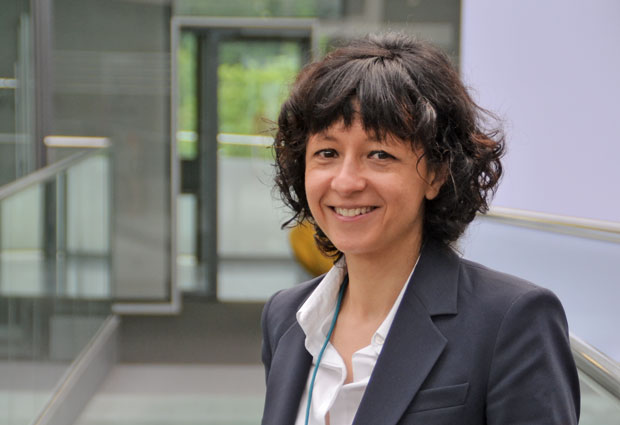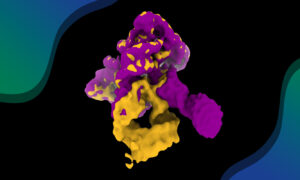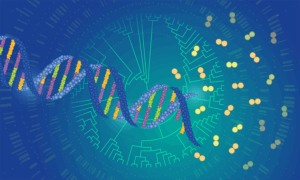
Gene editing 3.0
Emmanuelle Charpentier, an alumna of the Nordic EMBL Partnership for Molecular Medicine, sheds light on how CRISPR–Cas9 turned from a side project into a worldwide revolution

BY ISABELLE KLING and MARGAUX PHARES
Three molecules are enough to alter a genome. And three years is how long it took microbiologist Emmanuelle Charpentier to discover not only how these molecules work together, but also how they can be used in a revolutionary gene editing technique (published in Nature in 2011 and Science in 2012). This system, called CRISPR–Cas9, is a naturally occurring defence mechanism that enables bacteria to fight viral infections. As Charpentier and her collaborator Jennifer Doudna at the University of California, Berkeley found, though, it can also be easily manipulated to add or mutate genes. Like a set of microscopic scissors, the nuclease Cas9 can be programmed to find and cut any sequence of DNA.
Their findings have led to a rapid expansion in applications of cut-and-paste genome editing techniques. In particular, CRISPR–Cas9 holds immense potential for combating diseases – from altering the genomes of mosquitoes carrying the Zika virus to staving off infections by the human immunodeficiency virus (HIV). Human clinical trials to assess the effectiveness of CRISPR–Cas9 against three types of cancer are due to begin in 2017.
Charpentier’s career has advanced rapidly in the past four years: one of the two seminal publications on CRISPR–Cas9 (published in Science) is in the top 5% of all research outputs scored by Altmetric, an alternative to traditional citation impact metrics to measure the impact of a publication. She is currently a Visiting Professor at the Laboratory for Molecular Infection Medicine Sweden (MIMS), Umeå University, which is part of the Nordic EMBL Partnership for Molecular Medicine, and she has recently been appointed as Director of the Max Planck Institute for Infection Biology in Berlin. She has also co-founded two biotechnology companies (CRISPR Therapeutics and ERS Genomics) and has received numerous awards, including the Gottfried Wilhelm Leibniz Prize, the Breakthrough Prize in Life Sciences, and, most recently, the Tang Prize in Biopharmaceutical Science.
EMBL got the opportunity to speak with Charpentier during this year’s EMBL Partnership Conference – ‘Perspectives in Translational Medicine’ – in Heidelberg. She discussed with us her time at Umeå University, the importance of fundamental research, and the far-reaching implications of CRISPR–Cas9 in our day-to-day lives.
Partnership perspectives in Heidelberg
Nearly 200 participants from EMBL and select partner institutes gathered in Heidelberg from 6–8 June 2016 for the Perspectives in Translational Medicine conference. The second event of its kind, and the first hosted at EMBL, took place in the context of the EMBL Partnership Programme and brought together EMBL’s partner institutes operating in the field of molecular medicine. From PhD students to institute directors, participants exchanged expertise in connecting basic science with medical research, intent on strengthening networks and building new collaborations.
How does CRISPR–Cas9 work, and what makes it such a powerful technique to edit DNA?
Although it might seem strange, bacteria can also suffer from infections – by viruses called phages – and have developed an adaptive immune system as a result. This means that they can ‘remember’ phages that have infected them in the past and can fight more efficiently against them if they strike again. At a molecular level, this ‘memory’ is made up of a small piece of phage DNA that is inserted into the bacteria’s genome and stored in a location called clustered regularly interspaced short palindromic repeats, or CRISPR. Think of it like the wall of a sheriff’s office in a western movie, with mug shots of outlaws to catch. When the outlaws come back to town, the sheriff goes after them armed with a copy of their mug shots and a weapon. Similarly, when a phage strikes again, the immune system of the bacteria goes after it armed with a molecular mug shot – a single short piece of RNA that matches the viral DNA stored in its genome – and a pair of molecular scissors called Cas9. Another RNA, called tracrRNA, triggers the maturation of this viral RNA sequence. The complex formed by these three molecules – viral RNA, tracrRNA, and the DNA-cutting enzyme Cas9 – recognises the invading DNA and snips it, thus disabling the phage and preventing infection.
CRISPR–Cas9 is easy to engineer: by modifying the sequence of the viral RNA, scientists can redirect the complex to another location on the DNA that will then be cut – like if someone gives the sheriff another mug shot of someone to catch. Our experiments showed that we could adapt this tool and use it to manipulate the DNA of any cell. We studied CRISPR–Cas9 initially in Streptococcus bacteria, but we now know a similar adaptive immune system exists in approximately 40% of bacteria.
What made you realise that you had discovered something big?
When I accepted my new position in Umeå in 2008, it took me almost a year to convince people to look at the connection of two systems – CRISPR and tracrRNA – that now defines the unique feature of the CRISPR–Cas9 mechanism. The CRISPR project was carried out with limited manpower and everyone else was very busy with other projects, which were more interesting than CRISPR–Cas9 at first sight. Above all: who is interested in an adaptive immune system in bacteria, anyway?!
I had a hunch that something interesting could be there
I cared, because I started my career in the field of bacterial genetics and I had a hunch that something interesting could be there. So, I kept pushing the idea. When my student from my former position at the University of Vienna set her mind to some experiments, the results were exciting, unexpected, yet breathtakingly simple – and it became clear to me that we were potentially studying a totally unknown and unique mechanism. The environment within the Nordic EMBL Partnership for Molecular Medicine was instrumental in helping us to achieve these results. Like scientists at EMBL, young researchers there receive the resources and space needed to pursue fundamental questions.
Like every scientist, I was in love with the mechanism I was studying. When you focus on the same mechanism and molecules every day, the moment when you finally understand how it functions always seems like a breakthrough. But the rest of the world might see it with different eyes, depending on whether or not it has useful applications right away. In the case of researching CRISPR–Cas9, my focus was on the science. I was really excited about what we had observed and I wanted to dig deeper into the workings of the mechanisms. The research projects in my laboratory have always had a focus on the understanding of basic mechanisms in bacteria that could lead to novel gene targeting technologies or novel anti-infective strategies. It was only when the technique attracted a number of high-profile awards, I then realised its global scope beyond the range of versatile applications.
The CRISPR–Cas9 system is now being used in almost every molecular biology lab in the world – how do you feel about that?
When it became clear that we could tweak this mechanism into a powerful gene editing technology, I followed my initial interest in seeing the technology applied to the field of human medicine. It is quite rare in science to see the development of so many applications for one technology, and so quickly. Exactly how the different applications will develop in future is still hard to define, but I am very pleased to see that many medical geneticists are embracing it. In the long term, it would be tremendous if CRISPR could directly treat human genetic disorders. I have co-founded, together with Rodger Novak and Shaun Foy, a biotech company called CRISPR Therapeutics with the goal of pushing forward this endeavour.
However, it is also important that society and politicians understand and be mindful of the complex implications of this simple yet sophisticated and versatile technology. Further down the line, some research or resulting applications, for example in relation to genetically modified organisms in agriculture, could require widespread societal discussion and debate. Ultimately, decisions will need to be made. It is important and very good that groups are forming at different levels to discuss the opportunities and potential consequences of the CRISPR–Cas9 technology.
Do you think that being a woman has influenced your career? How could we improve the situation of women in science?
When it comes to my work, I want to be considered for my scientific expertise first and foremost. This is something that I’ve always fought for. I have always had reservations about politics based on quotas. I consider them plasters on a wound that will not make the wound disappear: only a change in mentality will end discriminations, like those against women. Ideally, you would hire people for their qualifications, research projects, and whether they fit well in your work environment – not whether they are male or female. Strong education programmes focusing on these issues, from an early age, have the potential to change mentalities and thereby make progress on discrimination issues. But that will take some time. It’s not a question of being politically correct – it is one of observing a certain reality and questioning it.
Note from the editors: Quotas are a matter of heated debate in science. We will be publishing interviews with people who offer different perspectives on the issue, so watch this space


